Last Updated on June 12, 2023 by Laura Thompson
Flemish Giant is one of the oldest and the largest rabbits in the world.
While some claim that the Flemish Giant rabbit is descended from the Patagonian and or stone rabbits – breeds which were renown to have been raised for both their fur and as a meat breed of rabbits – others claim that they are descended from the Argentinian Patagonian rabbit.
The truth is no one knows for certain how these magnificent creatures originally came to be. But for one thing, they all agree, that the Flemish Giant is by far one of the oldest rabbit breeds in the world.
Contents
- 1 Brief History of the Flemish Giant
- 2 Flemish Giant Size, Weight and Lifespan
- 3 Appearance of Flemish Giant Rabbit
- 4 Flemish Giant Colors
- 5 How to Care for Flemish Giant Rabbit
- 6 Flemish Giant Diet and Recommended Food
- 7 How to Feed Flemish Giant Rabbits
- 8 What do Flemish Giant Rabbits eat?
- 9 Cautions that you should consider when feeding your Flemish Giant rabbit
- 10 Poop Munching
- 11 The Flemish Giant Behavior and Temperament
- 12 Flemish Giant Health Issues
- 13 Finally, Is Flemish Giant a Good Pet?
Brief History of the Flemish Giant
The breed arrived in America in the 1890s from the nations Belgium and England (holder of the Flemish Giant’s first authentic record of existence).
It started to feature in livestock shows very early in the 20th century, and by 1915 the National Federation of Flemish Giant Rabbit Breeders (NFFGRB) was established.
In America, the Flemish Giant was recognized as a breed by the American Rabbit Breeders Association (ARBA) in 1929. It was bred then for its meat and fur. However, it is now bred for show (renown to possess the reposeful gaze), and as pets.
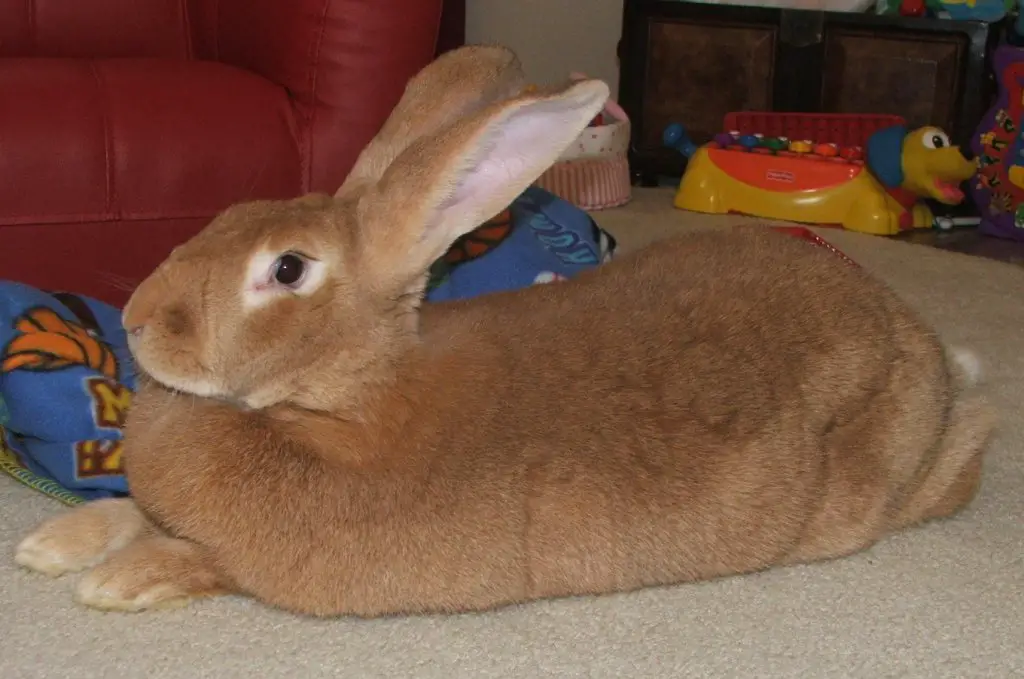
Flemish Giant Size, Weight and Lifespan
The Flemish Giant rabbits weigh between 12-14 pounds on average and reach a length of up to 2.5 feet. The females (does) are usually larger than the males (bucks), and often are about 14 pounds in weight.
On the other hand, the bucks average 13 pounds in weight. When overweight, Flemish rabbits are known to exceed 20 pounds and they can grow up to 30 inches lengthwise.
These numbers just go to show why they’re famously known as one of the largest breeds of domestic rabbits in the world.
The Flemish giant’s rabbit lifespan is 8-13 years.
Appearance of Flemish Giant Rabbit
These rabbits have a long and powerful body, with a semi-arched spine, and flared out (wide) hips. Consequently, they are described as having a mandolin shape (akin to the shape of a regular guitar pick).
The fur on this breed is glossy, short, and dense.
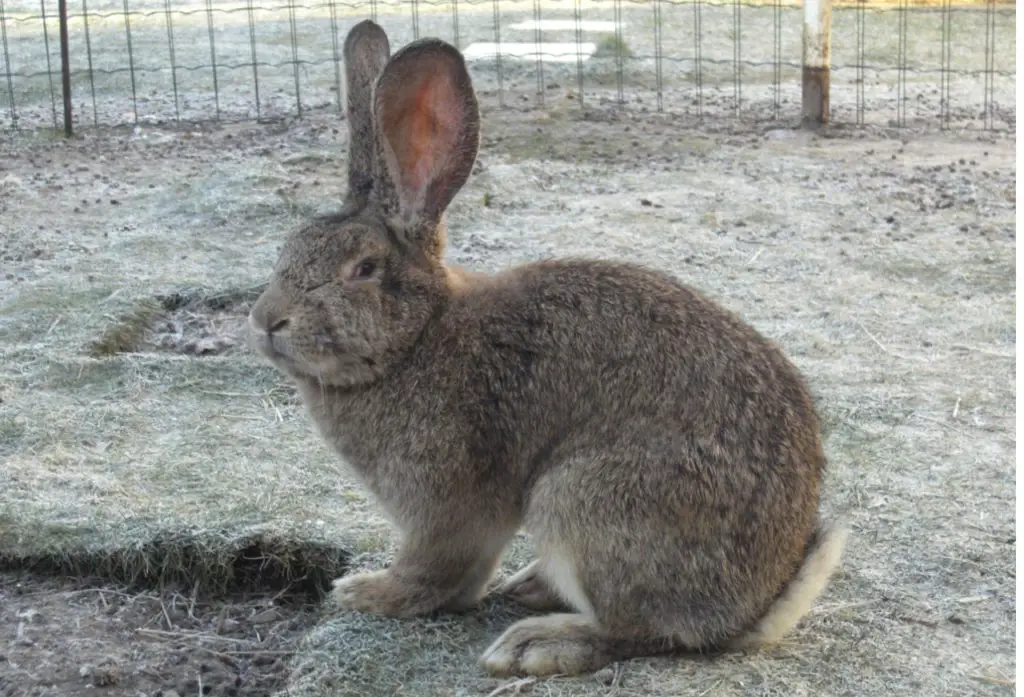
Male and Female Flemish Giants are different. The buck and does are distinctively different in appearance. While the buck has a broader head in comparison to the doe, the doe unlike the buck has a dew flap under her chin.
The dew flap helps with keeping her kits warm. Her litter averages between 5-12 kits and they are born after a gestation period of 31 days.
The does mature earlier and reach full adulthood between 8-12 months of being born. The bucks may take up to 18 months to fully mature.
it is worth noting that the Flemish Giant is extremely similar to the British Giant Rabbit.
Flemish Giant Colors
The main Flemish rabbit breed colors which they usually come in are:
- Sandy – Reddish-brown
- Fawn – Rich golden straw
- Light Grey
- Steel Grey
- White – Totally white with pink eyes
- Black – Mainly black with a slate blue under color
- Slate Blue – Slate blue color with blue-green eyes
Recently, albeit still questionable, Flemish Giants have been recorded to appear in colors like lilac and broken.
How to Care for Flemish Giant Rabbit
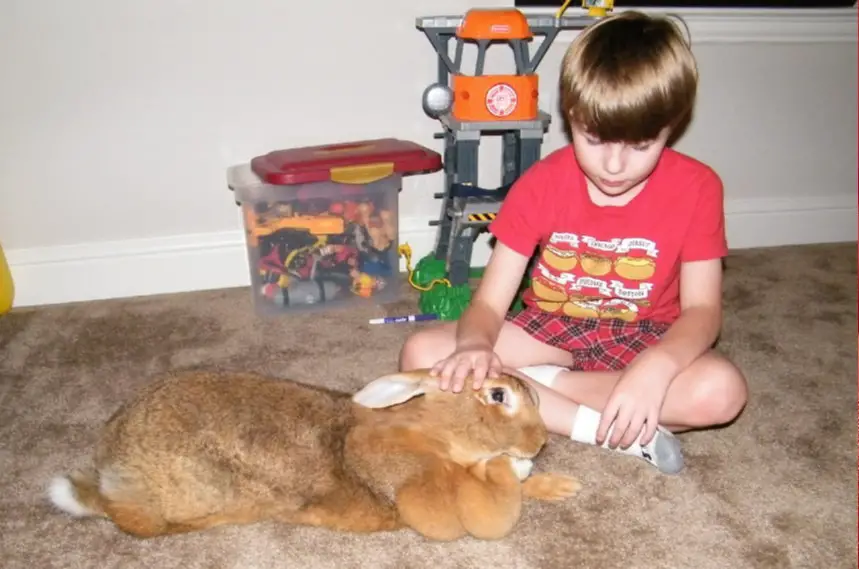
These giants are very adaptable to both indoor and outdoor living. Regardless, their enclosures need to be spacious enough to enable the rabbits stretch and hop freely.
Also, these enclosures need to be void of stairs and ramps because of the rabbit’s weight, as well as have a solid base. Not meshed wires which make them susceptible to sore-hocks (an inflammation of the rabbit’s foot).
This solid base should be overlaid with some form of bedding (straw) to simulate the Flemish rabbit’s natural habitat. It is paramount that the bedding be cleaned daily and changed weekly.
Once a week is more than enough for grooming time, except during spring when they usually molt. Then they should be groomed at least twice a week with a slicker brush, and that outside, because they do release large amounts of fur.
Thinking of Buying or Adopting a Flemish Giant Rabbit?
We have updated the list of Flemish Giant Rabbits for sale here for 2021, showing only the most reputable breeders in the US.
Flemish Giant Diet and Recommended Food
Their dietary requirements are no different from that of any other rabbit breed: hay, pellets vegetables. However, like giants, they do eat a lot more than any other rabbit breed.
Also, do note that rabbits do not naturally eat seeds, dried fruit, or cereal. Therefore, although there are pellets that contain these, they are of no health benefits to the rabbit.
The importance of hay to the rabbit cannot be overemphasized – it is the chief source of fiber for the Flemish rabbit.
In addition to hay and pellets, the vegetables and fruit served to the rabbit, should be varied daily. One should always ensure that the Flemish rabbit is introduced to any new diet, slowly. They need enough drinking water too.
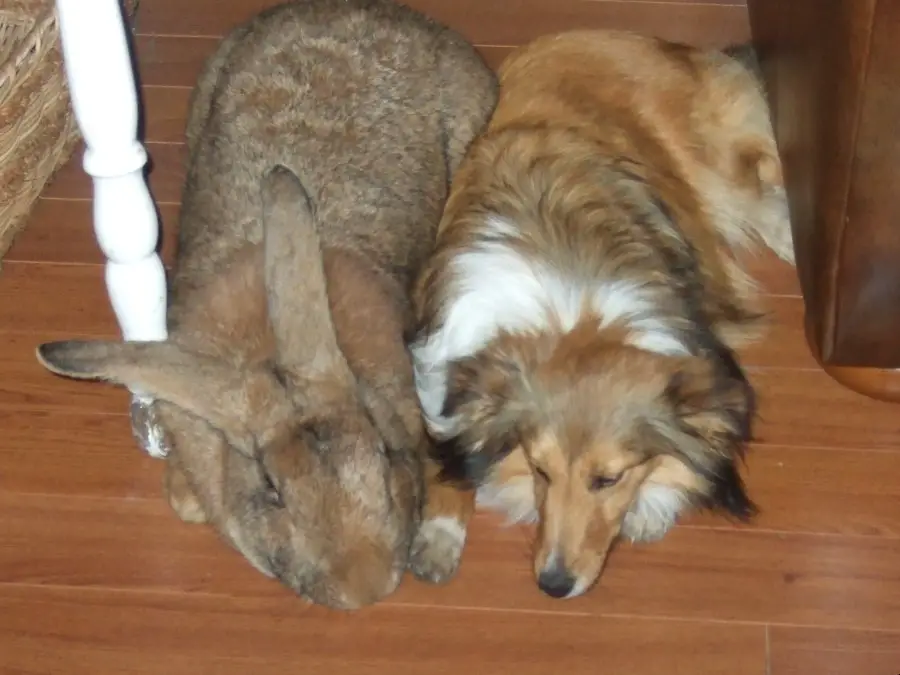
Flemish Giant rabbits are large in size and need a diet that is high in protein. These rabbits have been bred to grow larger than normal, so they require more food than your average bunny.
Food items such as carrots, lettuce, apples, bananas, and other fruits can be given, but these should be limited because Flemish Giants already get all the nutrients their bodies need from hay.
The food items that should never be given to Flemish Giant Rabbits include potatoes, corn on the cob, or any foods with corn as an ingredient and dried fruit like raisins or apricots.
How to Feed Flemish Giant Rabbits
These giant bunnies require daily care to stay healthy. A constant supply of fresh clean water, a high-quality diet, hay, and pellets are all important parts in order for him or her to reach his full potential and have healthy teeth.
Feeding them with brand names that provide certain nutrients or getting exact amounts isn’t necessary because each animal has different needs based on their size and health history but this will help keep your pet happy!
The way you feed your animal can impact how they live. So, it’s important not only what type of food you give them, but also about how much time you spend feeding good stuff like fruit or vegetables.
What do Flemish Giant Rabbits eat?
Flemish Giant Rabbits eat a diet that is designed for their unique dietary needs.
In general, this is the recommended breakdown of the type of food and its portions you should feed your rabbit;
- Hay – 70%
- Protein pellets – 20% (no more than one-third of your rabbit’s daily diet)
- Treats – 10%
Hay
Flemish Giant Rabbits, like most bunnies, tend to eat hay all the time. It’s important to give them access to have enough hay whenever they want. There are many types of hay available.
Alfalfa Hay
- Alfalfa is a variety of green leaves that can be brittle and have flat surfaces.
- It typically has dark lime to yellow/green-brown coloring, but this can vary depending on the season.
- Alfalfa contains high levels of calcium and calories; however, it may also cause bladder sludge or wet droppings in rabbits over two years old.
Timothy Hay
- Timothy hay is the most recommended type of hay for rabbits because it not only has soluble fiber but calcium as well.
- It helps your rabbit stay healthy and happy, which means you won’t have to worry about them getting sick or having any other problems at all!
- Timothy Hay is the best choice when shopping for food that will keep your bunny happy and healthy.
- This option provides lots of great benefits just like Alfalfa does without some risks involved with feeding Timothy Grass instead.
Orchard Grass
- When it comes to the nutritional content of different types of grass, orchard grass is lower than Timothy hay.
- Orchard Grass has a very similar appearance and texture as that among Timothy’s blades, but there are small pieces missing from its cattails which can be spotted with close observation, indicating they may not have soaked up nutrients in their lifetime like other varieties such as Timothian will do over time.
- The coloration tends to range between pale brown on one end and light yellow at the opposite extreme; this indicates difficulty converting sunlight into usable food sources for cattle grazing.
Fruits
Your Flemish Giant Rabbits can enjoy some juicy fruit on occasion, but be mindful of the sugar content.
It’s true that rabbits were not designed to have a high-sugar diet in the wild; they eat mostly grass and hay which is low in sugar.
When it comes down to feeding your pet rabbit, there are many things you need to keep track of!
One thing is portioning: with fruits, for example, if too much gets into their system at once, then this will upset their digestive system because they’re used to eat lower sugars such as vegetables and hay/grass from nature.
The safest fruits to feed your Flemish Giant Rabbit are:
- Apples (seedless)
- Assorted berries
- Bananas
- Mangoes
Vegetables
Vegetables also are great for Flemish Giant rabbits!
These nutrient-rich goodies will fill your bun with fiber, vitamins, and minerals without any sugar or fat.
Your bunny can have these a couple of times weekly in addition to their fruit diet.
Safest vegetables to feed your Flemish Giant rabbit include;
- Parsley
- Spinach
- Beet greens
- Mustard greens
- Dandelion greens
- Radish tops
- Carrot tops
- Mint
- Basil
- Celery (cut into very small pieces)
- Edible flowers
- Bell pepper
Water
As a Flemish Giant, your rabbit is especially sensitive to heat.
Make sure they have access to plenty of fresh water at all times. Make adequate cooling arrangements during particularly warm days or when the temperature rises above 85 degrees Fahrenheit for an extended period of time.
Cautions that you should consider when feeding your Flemish Giant rabbit
The digestive system of a rabbit is complex and delicate.
All rabbits are prone to digestive problems, so it’s important not to introduce new foods too quickly or give them large amounts of one type of food at once.
Introduce new types slowly and only feed your bunny small portions from many different sources on any given day for the best health outcomes possible!
Flemish Giant Rabbits also have a sweet tooth just like us! Like with humans, too much of the wrong thing can be bad.
For rabbits, fruits should only be given as desserts or training treats because it may cause weight gain and tummy upset.
When feeding peppers, apples, cherries, peaches, apricots, remove all seeds/pits/stems to avoid toxicity due to their phytochemicals (toxic chemicals). Hold off on peaches and apricots in particular until your bunny is above 6 months old.
At the same time, you should never feed your Flemish Giant rabbit the following food:
- Chocolate
- Rice
- Sugary or Starchy foods
- White Bread
- White Potato
Poop Munching
Yes, the Flemish Giant eats its feces! Please do not be alarmed! Due to the unique technicalities of their digestive system, Fleming Giants for nutritional purposes, eat, excrete, and eat again, some of its still digestible fiber.
Nevertheless, for the remaining feces that is not consumed by the rabbit, considering that their diets mainly consist of vitamin-rich foods, they (feces) can serve as great manure, for garden plants.
The Flemish Giant Behavior and Temperament
These rabbits are also known as gentle giants, as well as considered to be well-mannered and docile. However, they can be fast if need to be.
The Flemish rabbit is definitely not an active breed, but it is healthy for them to have an enclosed outdoor space where they can roam (unlike smaller rabbits that burrow) and play. Preferably a grass field, for at least 3-5 hours daily.
If you don’t have enough outdoor space, try to find or create an area indoors where your Flemish Giant bunny can roam. And most important, is gnaw-proof! Find toys which they can chew on (balls, wood, or rubber). It will keep your wires and stuff from getting chewed on.
Furthermore, these rabbits are very easy to maintain. Interestingly, they can be harnessed with dog harnesses designed for medium-sized dogs. They can be introduced to the harness through progress equals reward system.
They are intelligent too and can obey some basic instructions. However, training them might be more challenging than training a dog or cat. They cooperate more when they, having won the trust of the handler, are gently coaxed into doing anything.
When they sense danger, their first response is to freeze and then flee if the danger becomes too close. If they are not trained properly, they could grow to be aggressive and bite often.
On the other hand, when trained dutifully and patiently, they can use a litter box, as well as occasionally sit on their owner’s laps.
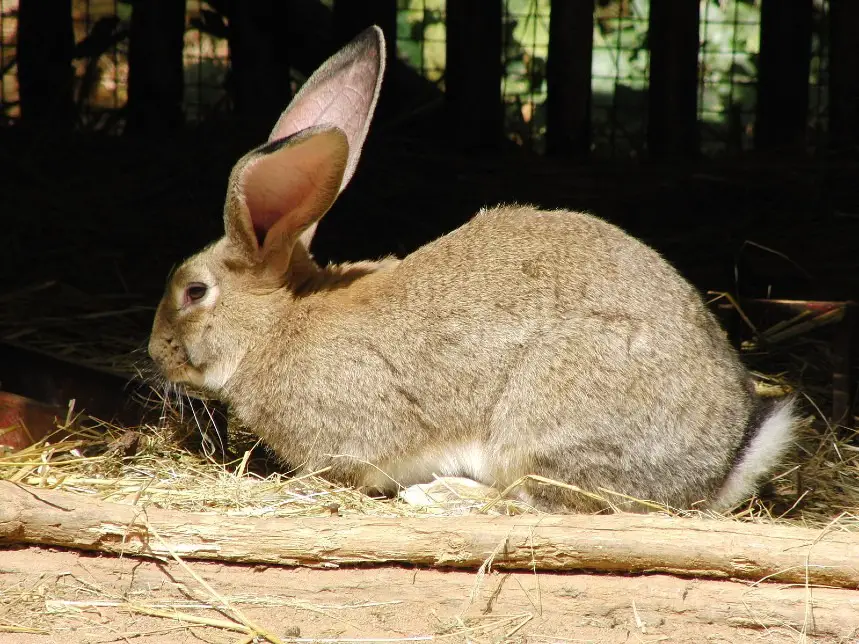
Flemish Giant Health Issues
Some common health issues with the Flemish Rabbit are:
- Snuffles
- Uterine tumors
- Calicivirus
- Myxomatosis
- Overgrown teeth
The issue of having overgrown teeth can be overcome simply by ensuring that the rabbit’s diet is constantly rich (at least 70%) in fiber (hay) which files the rabbit’s teeth whenever it gnaws on its food.
Also, things like mats (straw, wicker), wood (rabbit friendly), and straw baskets, can also help keep the Flemish rabbit’s teeth, constantly trim. Additionally, these giants should be dewormed (treat to free them of worms) every six months and examined frequently for ear mites especially if the rabbits are housed outdoors.
Furthermore, their dense fur does make them prone to fur mites and overheating during the summer. They do struggle in temperatures above 30 degrees Celsius.
Therefore, ensuring that the rabbit is kept cool always should be prioritized. Their outdoor dwellings must have areas shielded away from direct sunlight.
Finally, Is Flemish Giant a Good Pet?
Any person that can afford to provide ample space, plenty of food, regular health care, and time for regular and daily interactions with the Flemish rabbit, is bound to reap the benefits of having a very compliant, docile, and trusting pet.
Laura is an experienced wildlife rehabilitator and conservationist residing in Madison, Wisconsin. Her love for rabbits was sparked during her early career when she nursed an injured wild rabbit back to health. Today, she runs “Hoppy Haven”, a rehabilitation center dedicated to the care and release of injured wild rabbits.

Educative post, learned a lot. So glad I discovered your blog, and managed to learn new things.
Keep posting articles, it is really helpful.
King regards,
Thomassen Hessellund
Where can i buy the Flemish giant rabbit?
I want to buy 2 doe and 1 buck from different litters